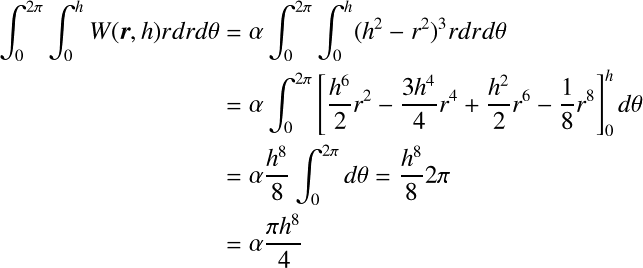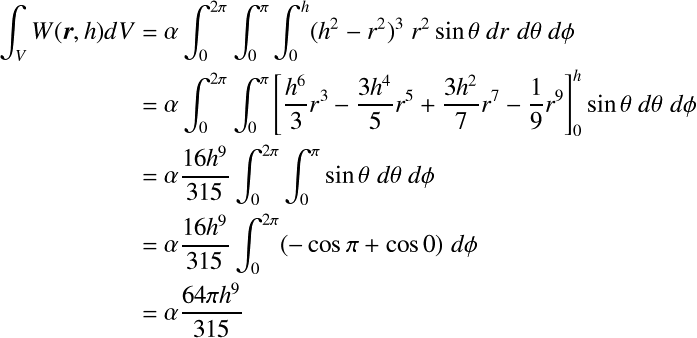![[PukiWiki] [PukiWiki]](image/pukiwiki.png)
Poly6 kernel[1]†密度計算など.rは2乗項しか含まれていないので,平方根を計算しなくてよいのがメリット. 勾配は, ラプラシアンは, グラフにすると, ラプラシアンの値は第2軸(右側)参照 コード例 /*!
* Poly6カーネル関数値の計算
* @param[in] r 距離
* @param[in] h 有効半径
* @return 関数値
*/
inline double RxKernelPoly6(const double &r, const double &h)
{
if(r >= 0.0 && r < h){
double q = h*h-r*r;
return 315.0/(64.0*RX_PI*pow(h, 9))*q*q*q;
}
else{
return 0.0;
}
}
/*!
* Poly6カーネル関数勾配値の計算
* @param[in] r 距離
* @param[in] rij 相対位置ベクトル
* @param[in] h 有効半径
* @return 勾配値
*/
inline Vec3 RxKernelPoly6G(const double &r, const Vec3 &rij, const double &h)
{
if(r >= 0.0 && r < h){
double q = h*h-r*r;
return -945.0/(32.0*RX_PI*pow(h, 9))*q*q*rij;
}
else{
return Vec3(0.0);
}
}
/*!
* Poly6カーネル関数ラプラシアンの計算
* @param[in] r 距離
* @param[in] h 有効半径
* @return ラプラシアンの値
*/
inline double RxKernelPoly6L(const double &r, const double &h)
{
if(r >= 0.0 && r < h){
double q = h*h-r*r;
return -945.0/(32.0*RX_PI*pow(h, 9))*(3*q*q-4*r*r*q);
}
else{
return 0.0;
}
}
hが定数ならば,上式のα部分はグローバル変数にでもあらかじめ計算して入れておいて使った方がよい. Spiky kernel[1,2]†圧力項計算用.Poly6カーネルがr=0で勾配が0になり,パーティクルがクラスターを構成してしまう問題を解決する. 勾配は, ラプラシアンは, [2]での定義は, グラフにすると, ラプラシアンの値は第2軸(右側)参照 コード例 /*!
* Spikyカーネル関数値の計算
* @param[in] r 距離
* @param[in] h 有効半径
* @return 関数値
*/
inline double RxKernelSpiky(const double &r, const double &h)
{
if(r >= 0.0 && r < h){
double q = h-r;
return 15/(RX_PI*pow(h, 6))*q*q*q;
}
else{
return 0.0;
}
}
/*!
* Spikyカーネル関数勾配値の計算
* @param[in] r 距離
* @param[in] rij 相対位置ベクトル
* @param[in] h 有効半径
* @return 勾配値
*/
inline Vec3 RxKernelSpikyG(const double &r, const Vec3 &rij, const double &h)
{
if(r >= 0.0 && r < h){
double q = h-r;
return -45.0/(RX_PI*pow(h, 6))*q*q*rij/r;
}
else{
return Vec3(0.0);
}
}
/*!
* Spikyカーネル関数ラプラシアンの計算
* @param[in] r 距離
* @param[in] h 有効半径
* @return ラプラシアンの値
*/
inline double RxKernelSpikyL(const double &r, const double &h)
{
if(r >= 0.0 && r < h){
double q = h-r;
return -90.0/(RX_PI*pow(h, 6))*(q*q/r-q);
}
else{
return 0.0;
}
}
hが定数ならば,上式のα部分はグローバル変数にでもあらかじめ計算して入れておいて使った方がよい. Viscosity kernel[1]†粘性拡散項計算用.Laplacianが線型な関数になる. 勾配は, ラプラシアンは, グラフにすると, ラプラシアンの値は第2軸(右側)参照 コード例 /*!
* Viscosityカーネル関数値の計算
* @param[in] r 距離
* @param[in] h 有効半径
* @return 関数値
*/
inline double RxKernelViscosity(const double &r, const double &h)
{
if(r >= 0.0 && r < h){
double q = r/h;
return 15.0/(2.0*RX_PI*pow(h, 3))*(-0.5*q*q*q+q*q+0.5/q-1);
}
else{
return 0.0;
}
}
/*!
* Viscosityカーネル関数勾配値の計算
* @param[in] r 距離
* @param[in] rij 相対位置ベクトル
* @param[in] h 有効半径
* @return 勾配値
*/
inline Vec3 RxKernelViscosityG(const double &r, const Vec3 &rij, const double &h)
{
if(r >= 0.0 && r < h){
double q = r/h;
return 15.0/(2.0*RX_PI*pow(h, 5))*(-1.5*q+2-0.5/(q*q*q))*rij;
}
else{
return Vec3(0.0);
}
}
/*!
* Viscosityカーネル関数ラプラシアンの計算
* @param[in] r 距離
* @param[in] h 有効半径
* @return ラプラシアンの値
*/
inline double RxKernelViscosityL(const double &r, const double &h)
{
if(r >= 0.0 && r < h){
double q = h-r;
return 45.0/(RX_PI*pow(h, 6))*q;
}
else{
return 0.0;
}
}
hが定数ならば,上式のα部分はグローバル変数にでもあらかじめ計算して入れておいて使った方がよい. Spline kernel[3,4]† ここで, 勾配は,  ここで, ラプラシアンは,  ここで, グラフにすると, ラプラシアンの値は第2軸(右側)参照 Super Gaussian kernel[3]†勾配は, ラプラシアンは, グラフにすると, ラプラシアンの値は第2軸(右側)参照 コード例 /*!
* Gaussianカーネル関数値の計算
* @param[in] r 距離
* @param[in] h 有効半径
* @return 関数値
*/
inline double RxKernelSuperGaussian(const double &r, const double &h)
{
double q = r/h;
return 1.0/(pow(RX_PI, 1.5)*pow(h, 3))*(2.5-r*r)*exp(-q*q);
//return 1.0/(sqrt(RX_PI)*h)*exp(-q*q);
}
/*!
* Gaussianカーネル関数勾配値の計算
* @param[in] r 距離
* @param[in] rij 相対位置ベクトル
* @param[in] h 有効半径
* @return 勾配値
*/
inline Vec3 RxKernelSuperGaussianG(const double &r, const Vec3 &rij, const double &h)
{
double q = r/h;
return -2.0/(pow(RX_PI, 1.5)*pow(h, 3))*(1.0+2.5/(h*h)-q*q)*exp(-q*q)*rij;
}
/*!
* Gaussianカーネル関数ラプラシアンの計算
* @param[in] r 距離
* @param[in] h 有効半径
* @return ラプラシアンの値
*/
inline double RxKernelSuperGaussianL(const double &r, const double &h)
{
double q = r/h;
return 2.0/(pow(RX_PI, 1.5)*pow(h, 3))*(2.0*q*q-(1.0+2.5/(h*h)-q*q)*(1.0-2.0*q*q))*exp(-q*q);
}
hが定数ならば,上式のα部分はグローバル変数にでもあらかじめ計算して入れておいて使った方がよい. Fourth-order weighting function†勾配は, ラプラシアンは, グラフにすると, ラプラシアンの値は第2軸(右側)参照 コード例 /*!
* Fourth-order重み関数値の計算
* @param[in] r 距離
* @param[in] h 有効半径
* @return 関数値
*/
inline double RxKernelFourth(const double &r, const double &h)
{
double q = 3*r/h;
if(q >= 0.0 && q < 1.0){
double q3 = (3-q)*(3-q)*(3-q)*(3-q)*(3-q);
double q2 = (2-q)*(2-q)*(2-q)*(2-q)*(2-q);
double q1 = (1-q)*(1-q)*(1-q)*(1-q)*(1-q);
return 9.0/(40.0*RX_PI*pow(h, 3))*(q3-6.0*q2+15.0*q1);
}
else if(q >= 1.0 && q < 2.0){
double q3 = (3-q)*(3-q)*(3-q)*(3-q)*(3-q);
double q2 = (2-q)*(2-q)*(2-q)*(2-q)*(2-q);
return 9.0/(40.0*RX_PI*pow(h, 3))*(q3-6.0*q2);
}
else if(q >= 2.0 && q < 3.0){
double q3 = (3-q)*(3-q)*(3-q)*(3-q)*(3-q);
return 9.0/(40.0*RX_PI*pow(h, 3))*(q3);
}
else{
return 0.0;
}
}
/*!
* Fourth-order重み関数勾配値の計算
* @param[in] r 距離
* @param[in] rij 相対位置ベクトル
* @param[in] h 有効半径
* @return 勾配値
*/
inline Vec3 RxKernelFourthG(const double &r, const Vec3 &rij, const double &h)
{
double q = 3*r/h;
if(q >= 0.0 && q < 1.0){
double q3 = (3-q)*(3-q)*(3-q)*(3-q);
double q2 = (2-q)*(2-q)*(2-q)*(2-q);
double q1 = (1-q)*(1-q)*(1-q)*(1-q);
return -27.0/(8.0*RX_PI*pow(h, 4))*(q3-6.0*q2+15.0*q1)*rij/r;
}
else if(q >= 1.0 && q < 2.0){
double q3 = (3-q)*(3-q)*(3-q)*(3-q);
double q2 = (2-q)*(2-q)*(2-q)*(2-q);
return -27.0/(8.0*RX_PI*pow(h, 4))*(q3-6.0*q2)*rij/r;
}
else if(q >= 2.0 && q < 3.0){
double q3 = (3-q)*(3-q)*(3-q)*(3-q);
return -27.0/(8.0*RX_PI*pow(h, 4))*(q3)*rij/r;
}
else{
return Vec3(0.0);
}
}
/*!
* Fourth-order重み関数ラプラシアンの計算
* @param[in] r 距離
* @param[in] h 有効半径
* @return ラプラシアンの値
*/
inline double RxKernelFourthL(const double &r, const double &h)
{
double q = 3*r/h;
if(q >= 0.0 && q < 1.0){
double q3 = (3-q)*(3-q)*(3-q);
double q2 = (2-q)*(2-q)*(2-q);
double q1 = (1-q)*(1-q)*(1-q);
return 81.0/(2.0*RX_PI*pow(h, 5))*(q3-6.0*q2+15.0*q1);
}
else if(q >= 1.0 && q < 2.0){
double q3 = (3-q)*(3-q)*(3-q);
double q2 = (2-q)*(2-q)*(2-q);
return 81.0/(2.0*RX_PI*pow(h, 5))*(q3-6.0*q2);
}
else if(q >= 2.0 && q < 3.0){
double q3 = (3-q)*(3-q)*(3-q);
return 81.0/(2.0*RX_PI*pow(h, 5))*(q3);
}
else{
return 0.0;
}
}
hが定数ならば,上式のα部分はグローバル変数にでもあらかじめ計算して入れておいて使った方がよい. カーネル関数の係数計算†SPH法ではカーネル関数Wは以下の条件を満たすことを仮定している. これを満たすように各カーネルの係数が決定される.
例としてPoly6カーネル( ここで係数を 2次元では有効半径hの円を使って積分する.
下の図のように微少範囲  これが1となるためには と導かれる. 次に3次元の場合を考えてみよう.
下図左のように球の中心から表面まで伸びた角錐形状内の微少体積を考える.
各辺の長さは Poly6カーネルを代入して計算する. 
と導かれる. 参考文献†
|